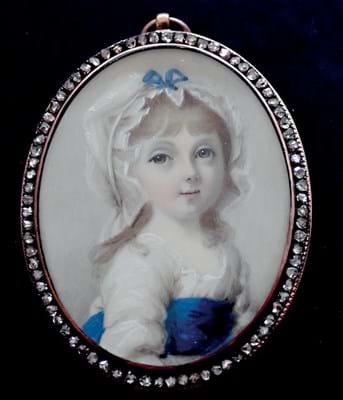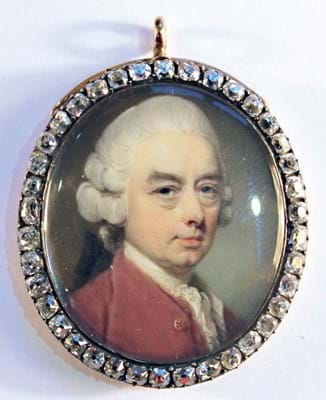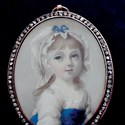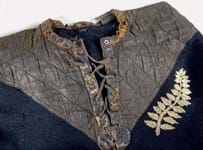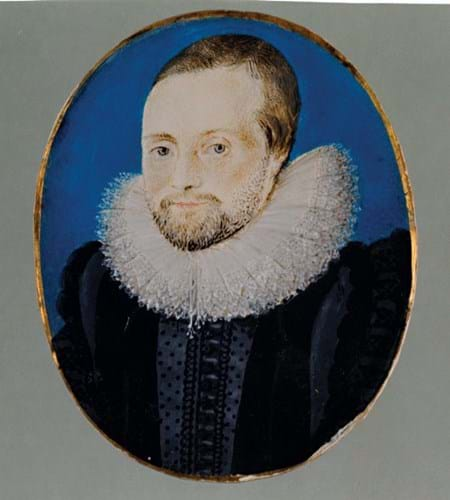
An early 17th century depiction of a Jacobean nobleman is one of the stand-out works in an exhibition of portrait miniatures from Ellison Fine Art.
A wealth of materials, stories and expert advice are on offer at this one-day selling show, organised by the dealership’s owner Claudia Hill and running on March 26 at the Royal Thames Yacht Club in Knightsbridge, London.
For Hill, who has 40 years’ experience in the field, the unknown Jacobean sitter is a favourite and, she predicts, is likely to be a highlight for visitors.
Painted by Laurence Hilliard (1582-1648), the c.1605 miniature is offered in its original turned ivory box (the lid missing), which could have been worn in a small pouch hanging from a woman’s waist.
The artist was the son of master miniaturist Nicholas Hilliard (c.1547- 1619), one of the leading figures in a golden age of portrait miniature production in Elizabethan and Jacobean England. Lawrence was the only one of Nicholas’ seven children to go into the same profession, entering his father’s workshop in 1597 and eventually succeeding him as the king’s ‘limner’ (or ‘painter in little’) in 1619.
Though much of his work was assisting his father to multiply routine images of James I, a few rare images of private individuals do exist. The one in question is a prime example, offered at the show for £18,000.
“Arguably the most expensive pieces today are early portraits painted by the likes of Hans Holbein (c.1497-1543), Nicholas Hilliard and Isaac Oliver (c.1565-1617),” Hill says.

A 17th century miniature portrait of Henry Percy, 1st Baron Percy of Alnwick (d.1659), painted on vellum by John Hoskins (c.1595-1665), signed and dated 1653. It is offered for £22,000 at Ellison Fine Art’s show.
Celebrated period
Though the piece in question is not by one of these leading practitioners, it offers collectors a strong, rare image by an interesting artist from a celebrated time in the history of portrait miniature production.
“The interest in Elizabethan and Jacobean miniature portraiture has always been strong and is about to become ever more popular with the opening of two major exhibitions,” Hill adds. She refers to The National Portrait Gallery’s Elizabethan Treasures: Miniatures by Hilliard & Oliver (until May 19) and the Fitzwilliam Museum’s Secrets of a Silent Miniaturist on the works of Isaac Oliver (until August 18).
A new book on Hilliard has also been published, titled Nicholas Hilliard: Life of an Artist by Elizabeth Goldring.
These offer chances, perhaps, to learn and be inspired before launching (or enlarging) a personal collection.
Classical origins
The practice of painting in miniature was adopted from classical portrait medallions and was first used in the illustration of handwritten books (‘miniature’ comes from the Latin word ‘miniare’ meaning ‘to colour with red lead’).
They were used as propaganda for the monarchy, diplomatic presents, intimate family gifts and as tokens in courtship. Miniatures were also given as tokens of affection or completed to commemorate a special occasion.
Interest is about to become even more popular with the opening of two major exhibitions
By the 18th century, Hill says, many were set into bracelets, rings or lockets and were often designed to be worn as romantic mementos.
Such later works are also on offer at her show.
While earlier pieces were executed in watercolour on vellum backed with playing card, 18th century works such as the ones mentioned above were generally painted in watercolour on ivory, which was comparatively cheap and gave the works “a wonderful sense of illumination”.
These are now among the few items exempt from the upcoming ivory ban.
Miniatures of any media require special care including protection from heat, which can cause ivory to curl and crack, and light, which can cause paint to fade. Precise instructions on care can be found from dealers of good standing in the field.
For those starting a collection, Hill advises: “Always buy from a reputable source. There are a lot of fakes being offered for sale on the internet. If in doubt, seek help from the experts. Always buy the best you can afford, but buy what you like.”
The miniatures on show and others will also be available via her website.


